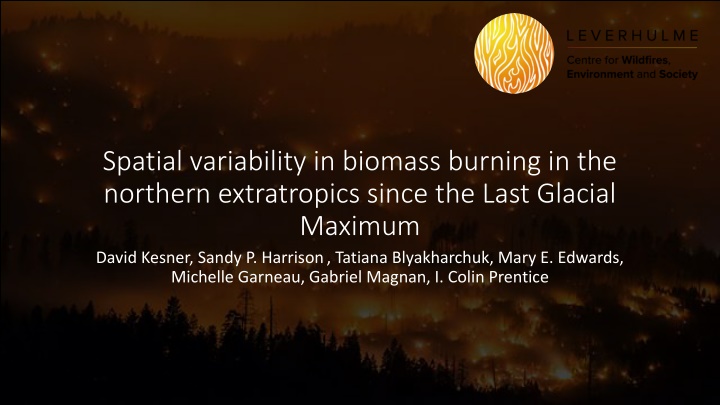
Spatial Variability in Biomass Burning in Northern Extratropics
Explore the spatial variability in biomass burning in the northern extratropics since the Last Glacial Maximum, examining paleo fires, composite curves, and sub-regions. Discover insights on biomass burning trends and potential natural vegetation. Future steps involve clustering charcoal records and analyzing fire frequencies in different regions.
Download Presentation

Please find below an Image/Link to download the presentation.
The content on the website is provided AS IS for your information and personal use only. It may not be sold, licensed, or shared on other websites without obtaining consent from the author. If you encounter any issues during the download, it is possible that the publisher has removed the file from their server.
You are allowed to download the files provided on this website for personal or commercial use, subject to the condition that they are used lawfully. All files are the property of their respective owners.
The content on the website is provided AS IS for your information and personal use only. It may not be sold, licensed, or shared on other websites without obtaining consent from the author.
E N D
Presentation Transcript
Spatial variability in biomass burning in the northern extratropics since the Last Glacial Maximum David Kesner, Sandy P. Harrison, Tatiana Blyakharchuk, Mary E. Edwards, Michelle Garneau, Gabriel Magnan, I. Colin Prentice
Paleo fires in the northern extratropics Data availability current public access database (GCD) Spatial biases in coverage of records (purple) Improved considerably by updating the GCD with contributed data from authors (still in progress). Most comprehensive northern site coverage to date Figure 1. Current data availability for the northern extratropics. Red and yellow dots are sites added to pre-existing GCD data.
Northern extratropics composite curve Curve limited to 15kya because lack of data before then Reflects global scale climate shift from glacial - interglacial state well established in Z previous literature Figure 2: Biomass burning in the northern extratropics > 45N since 15kya. Z scores were generated using a baseperiod of 200-4200BP, and curve generated using records that had at least 50% temporal overlap with the baseperiod. Bin width of 250yr, a local regression smoothing half-width of 750yr and 200 bootstrap resampling iterations. n = 383.
Sub-regions in northern extratropics Do different sub-regions of the northern extratropics show different paleo fire responses? Regionalized by modern vegetation distribution (Hengl et al. 2018) Hengl, T., Walsh, M. G., Sanderman, J., Wheeler, I., Harrison, S. P., & Prentice, I. C. (2018). Global mapping of potential natural vegetation: an assessment of machine learning algorithms for estimating land potential. PeerJ, 6, e5457.
N.A cool forest N.A cool mixed forest N.A Tundra Z EU cool mixed forest EU cool forest EU Tundra Figure 2. Biomass burning > 45N since 12kya in cool forest, cool mixed forest and tundra biome types in Eurasia and North America respectively. Z scores were generated using a base period of 200-4200BP, and curve generated using records that had at least 50% temporal overlap with the base period. All curves were generated using a bin width of 250 years, a local regression smoothing half-width of 750 and 200 bootstrap resampling iterations. Sample size for each curve: N.A. cool forest: n = 120; EU cool forest: n = 37; N.A. cool mixed forest: n = 74; EU cool mixed forest: n = 57; N.A. Tundra: n = 11; EU Tundra: n= 10.
Next steps Clustering the charcoal records (e.g. k-means) Change-point analysis find time periods to contrast spatial patterns (e.g. mid vs late Holocene) Compare fire frequencies in different regions? link to potential drivers (e.g. simulated gridded climate)? Any ideas?





















